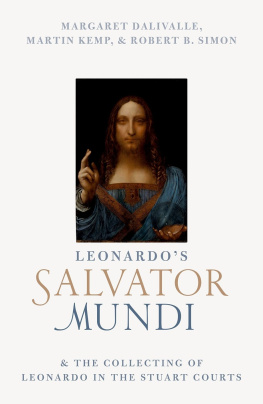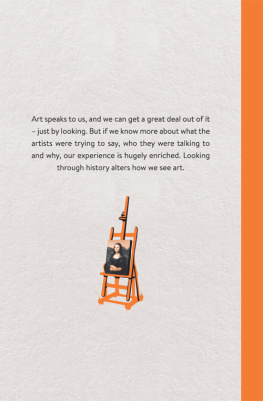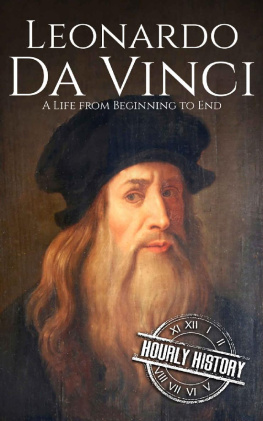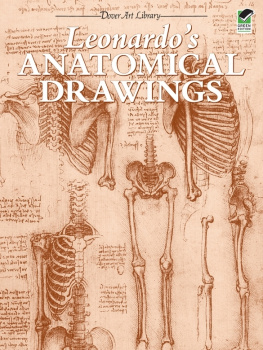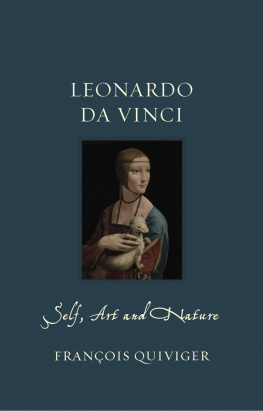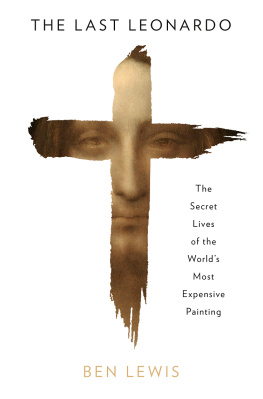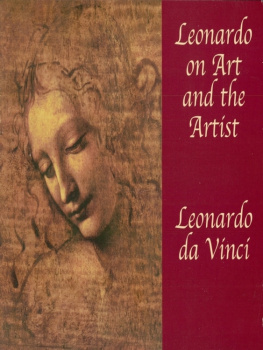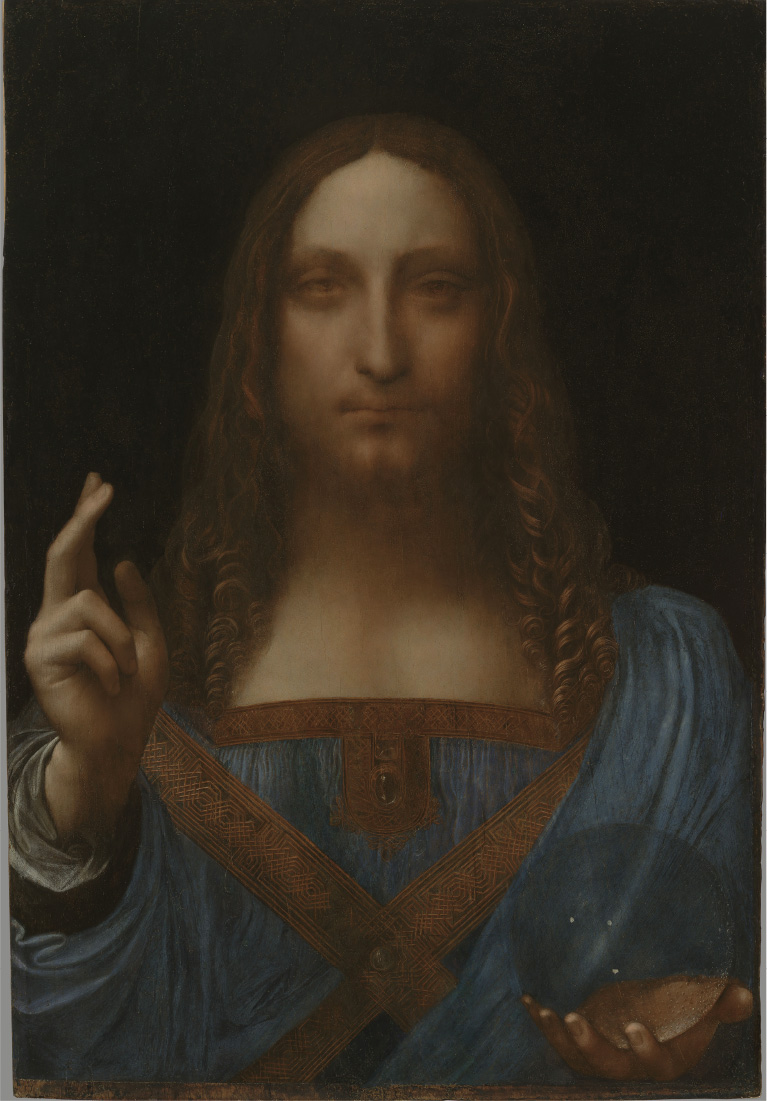
Salvator Mundi, final state.

Great Clarendon Street, Oxford, ox2 6 dp , United Kingdom
Oxford University Press is a department of the University of Oxford. It furthers the Universitys objective of excellence in research, scholarship, and education by publishing worldwide. Oxford is a registered trade mark of Oxford University Press in the UK and in certain other countries
Margaret Dalivalle, Martin Kemp, and Robert B. Simon 2019
The moral rights of the authors have been asserted
First Edition published in 2019
Impression: 1
All rights reserved. No part of this publication may be reproduced, stored in a retrieval system, or transmitted, in any form or by any means, without the prior permission in writing of Oxford University Press, or as expressly permitted by law, by licence or under terms agreed with the appropriate reprographics rights organization. Enquiries concerning reproduction outside the scope of the above should be sent to the Rights Department, Oxford University Press, at the address above
You must not circulate this work in any other form and you must impose this same condition on any acquirer
Published in the United States of America by Oxford University Press
198 Madison Avenue, New York, NY 10016, United States of America
British Library Cataloguing in Publication Data
Data available
Library of Congress Control Number: 2019943974
ISBN 9780198813835
ebook ISBN 9780192543295
DOI: 10.1093/oso/9780198813835.001.0001
Printed and bound by CPI Group (UK) Ltd, Croydon, cr0 4yy
Links to third party websites are provided by Oxford in good faith and for information only. Oxford disclaims any responsibility for the materials contained in any third party website referenced in this work.
Preface and Acknowledgements
This book is the fruit of an enthusiastic and harmonious collaboration to which the three authors have each contributed their own particular sets of knowledge and skills. Robert Simon was one of the two discoverers of the painting and has brought his high scholarly standards and personal experience to bear upon its startling emergence as a Leonardo. Martin Kemp has drawn upon his knowledge of the primary sources for Leonardos art and science to characterize the paintings role in the masters career. Margaret Dalivalle has intensively researched its provenance, documenting the presence of a Salvator Mundi in British collections, above all those of Charles I and II, and providing new insights into Leonardos fortuna in seventeenth-century Britain. The prime authorship of each of the parts of the book is indicated, but the authors take shared responsibility for the book as a whole and have contributed in various ways to the whole text.
For Robert Simon, there are too many people to acknowledge by name, since the saga of the painting involved the participation of many individuals in varying capacities, over several years. Among institutions the National Gallery, the Metropolitan Museum of Art, and the Conservation Center of the Institute of Fine Arts were crucial participants; and the curators, conservators, administrators, trustees, and staff of all provided significant assistance to the author and care to the painting. Many others were involved in the more practical concerns involving the painting: legal and financial matters, its protection and storage, handling and presentation, transportation, insurance, framing, and photography, commercial and press issues. To them are due thanks, as they are to the staffs of the libraries and institutions that have assisted in research matters, curators who made works of art and research materials available for study, scholars who responded to inquiries, and of course those mentioned in the text that follows. As has often been said in like situations, You know who you are. However, a few people merit special gratitude and acknowledgment here. This adventure began with the collaboration of Alexander Parish and continued over the years with his support, trust, counsel, and deep friendship. Dianne Modestini was not only the brilliant conservator that she is, but the introspective voice of the painting as it emerged from oblivion; her connection with the Salvator Mundi was at once both objective and intimate. Warren Adelson was a great supporter and consummate professional in all dealingsas were his family, associates, and staff. Sir Nicholas Penny crucially and bravely brought the painting to the attention of Leonardo scholars and then the public. Art historians who were especially generous in studying the painting and sharing their deep knowledge of the artist were David Alan Brown, David Ekserdjian, Mina Gregori, Keith Christiansen, Pietro Marani, and Luke Syson, as was John Somerville, for all matters Cook. Of the departed the author salutes Everett Fahy, Carlo Mastino, Mario Modestini, and David Rosand. Among conservators special thanks are due to Monica Griesbach, Shan Kuang, Nica Gutmann Rieppi, Charlotte Hale, Larry Keith, Beth Price, and Ken Sunderland. The practical management of the author was accomplished by Lucretia Baskin, Erin Marcell, Rachel Ropeik, and especially, Lydia Melamed Johnson. The help and support of close friends was vital: R. J. Berman, Claudia Einecke, Edward Leiter, and Patrick OReilly.
Martin Kemp, as always, owes an inestimable debt to his PA, Judd Flogdell, for stoic support in all aspects of his work and more specifically for her help with the preparation of the text. He has benefitted from the help and wisdom of many people who have played diverse roles, including Tetiana Bersheda, Lucy Blaxand, Micahel Brennan, Kathy Brewis, Victoria Brown, Sergey Chernitsyn, Martin Clayton, Franois de Poortere, Larry Keith, Domenico Laurenza, Arthur MacGregor, Nick Penny, Monica Price, Luke Syson, Ashok Roy, Dmitri Rybolovlev, Peter Silverman, Pilar Rosales Vzquez, and Frank Zllner.
Margaret Dalivalle is indebted to the many curators who provided access to their archives and to the scholars and specialists who generously gave their time to consider and discuss the key historical problems. Of these, Martin Clayton, Lucy Whitaker, and Desmond Shawe-Taylor of the Royal Collection deserve special mention and thanks. Jonathan Franklin, Librarian of the National Gallery, provided access to the transcript of the inventory of Charles II and helped discover the author of its internal annotations. She is grateful to Colin Harris, superintendent of special collections at the Bodleian Library, for his help and expertise about numerous early seventeenth-century manuscripts and printed sources she has consulted over the many years of research. Hugo Chapman and Antony Griffiths of the British Museum, and the Wenceslaus Hollar experts Nick Stogdon and Simon Turner, prompted fresh thoughts on the artists practice and interactions with collectors in the 1650s. Prof. Paul Monod of the Centre for Medieval and Renaissance Studies at Oxford, and Dr Robert Beddard, her former supervisor at Oriel College, acted as the ultimate sounding boards for the finer points of Stuart history. The expertise of Jeremy Wood and Rosalind Marshall was critical to her understanding of the Hamilton collection and its inventories. She is hugely indebted to those owners who extended access to their paintings, and associated documentation and data, in particular Lady Proby of Elton Hall, and the private owner of the Ganay

